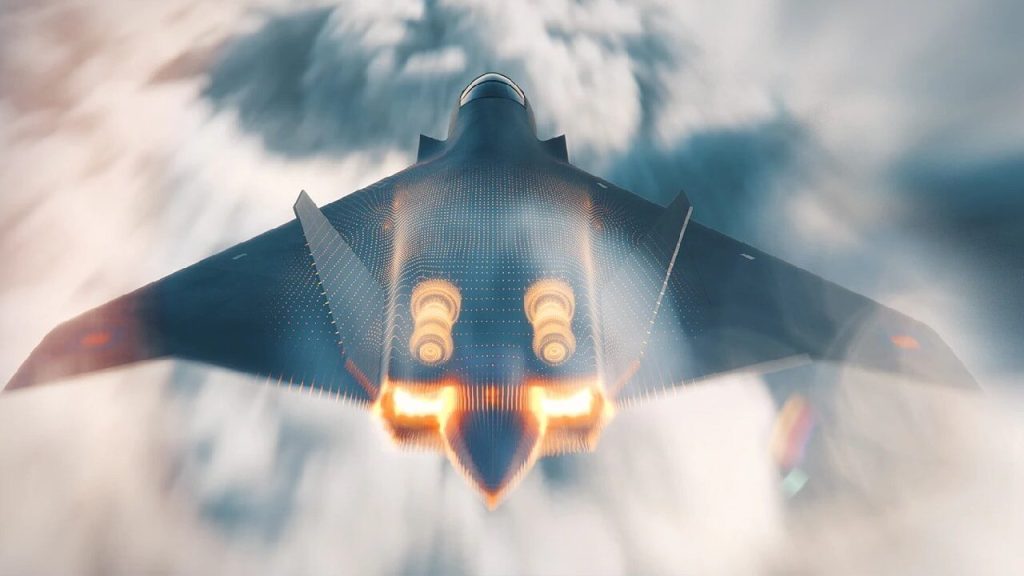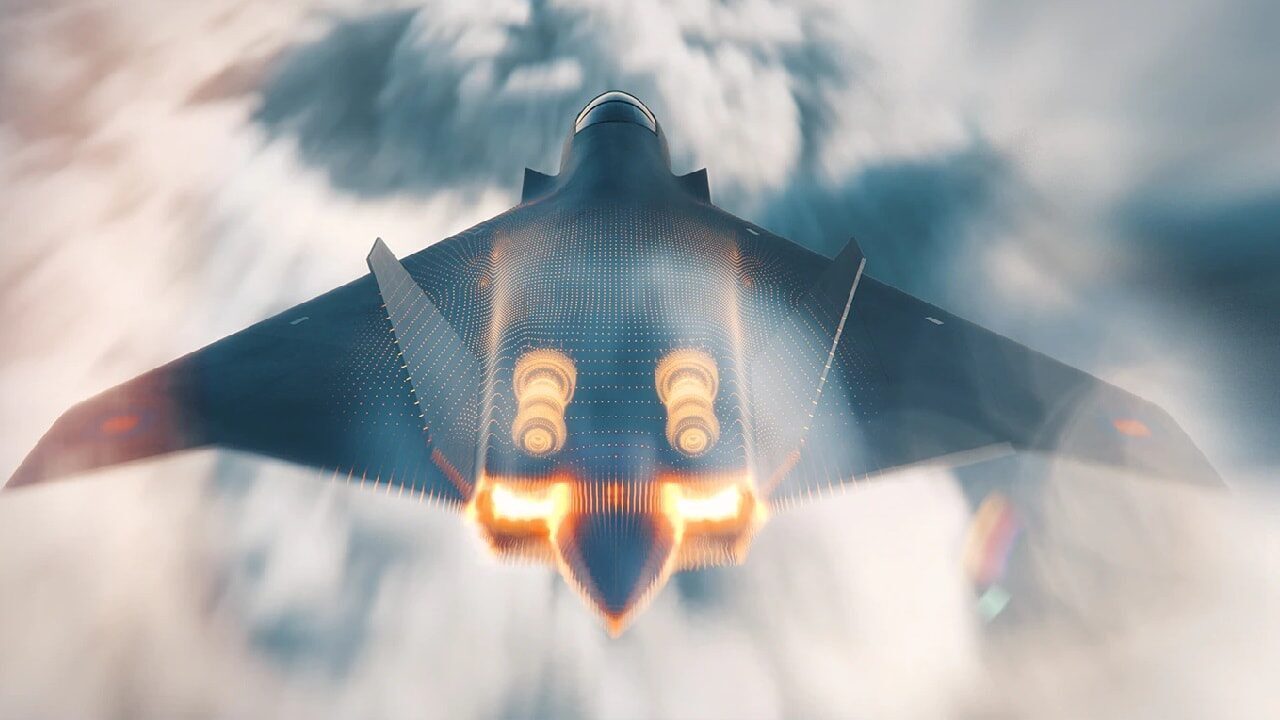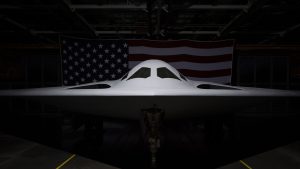Nations like Russia, China, and the United States should begin planning for what a 7th Generation fighter may entail as soon as possible.

Tempest Artist Rendition. Image Credit: Industry Handout.
“Indeed, the Tempest and NGAD programmes appear to be the sure bets for the future of military aviation. But, countries like Russia, China, and the United States should begin conceptualising what a 7th Generation fighter would look like as soon as possible.
Things will always be different in the future, giving us hope. At other times, progress will be made in giant leaps. Regarding military gear, we’ve reached a point where most developments are evolutionary, expanding on previous triumphs and proven features rather than revolutionary, which may lead designers down a whole new route.
The B-21 Raider, now in production, is a good example. The B-2 Spirit is mostly the inspiration for this new design; both aircraft have flying wings. For their part, most sixth-generation fighter designs have built upon the successes of fifth-generation planes.
Therefore, the big question is, what can we anticipate from the “next generation” beyond what’s already in prototype form? But not even aviation specialists can tell us what we’ll witness.
Despite its prominence in the media, “7th generation” is rarely discussed, as Janes’ aviation editor Gareth Jennings admitted.
Regarding aircraft production, “Tier 2” countries like Turkey, South Korea, etc., focus on fifth-generation jets, while “Tier 1” countries like the United States, the United Kingdom, France, and their allies are considering sixth-generation planes. “The 7th Generation isn’t an exactly ‘a thing’ yet,” Jennings continued. Nonetheless, we can extrapolate the development of past generations to speculate on what would be included in a 7th-generation jet.
Nevertheless, Jennings elaborated, even our idea of the generations of such was flexible.
Until today’s cutting-edge fighters, there was no such thing as a generational designation for aircraft.
According to Jennings, “it is important to first note that ‘generations’ do not really exist; they have only come into being as a way of classifying aircraft since Lockheed Martin used the term ‘fifth-generation’ to describe its F-35, and all older aircraft were kind of backfilled into whatever previous Generation they were determined to best fit.” It is how the F-4 became a third-generation aircraft, the Eurofighter a fourth-generation aircraft, and so on. Lockheed Martin admits that this was just a marketing ploy to make their product stand out from the competition, but the strategy worked, and the gimmick is now widely used.
Although these generational designations were only established retroactively, the United States Air Force has since defined their distinct capabilities:
Supersonic travel, pulse radar, and long-range missiles define the “Third Generation.
*Fourth Generation: Extreme adaptability; sensor fusion to varying degrees; pulse-doppler radar; a smaller radar signature; fly-by-wire controls; the ability to track and destroy incoming missiles visually; and more.
“The thing about generations is that each new generation concentrates on a handful of important performance features while keeping the key performance attributes that defined the generations before it,” Jennings said. Example: “The F-4 Phantom, a third-generation fighter jet, kept the supersonic speed that had come to define its predecessors while adding to it cutting-edge (at the time) mission computing and guided missiles.”
And then, the fourth Generation introduced fly-by-wire and sophisticated avionics, and the fifth included stealth, sensor fusion, and supercruise, as Jennings pointed out.
“The sixth Generation will take this and add capabilities that haven’t yet been publicly defined but are understood to include flexible payloads, an adaptable airframe, long-range sensing, analytics, and computing; laser-directed-energy weapons; advanced materials; intelligent maintenance; dynamically reconfigurable architecture; cyber protection; manned-unmanned teaming (MUM-T); trusted artificial intelligence (AI) reasoning; airspace integration; hypersonic-propulsor vehicles; and hypersonic-propulsor vehicles and hypersonic-propulsor vehicles; and hypersonic-propulsorTo these technological advancements, the sixth Generation adds a low price and cutting-edge production techniques.
Aircraft are special in that they have undergone consistent improvement for the past 80 years. Alternatively, the United States military still uses the “third-generation” M1 Abrams main combat tank (MBT). There are, nonetheless, two additional considerations. First, it was a revolutionary rather than an evolutionary step forward. Hence, it may have achieved armoured perfection until some new technology is discovered.
The M1 Abrams has undergone a process of steady improvement, which is not typical of fighter planes. Even after the introduction of the B-21 Raider, the B-52 Stratofortress will remain in service because of its continued usefulness as a bomber. Few military platforms have enjoyed as long a lifespan as the B-52, which could reach over 100 years of service when it is finally retired. Recent enhancements have made this possible.
The development of jet fighters, which will serve multiple purposes now and in the future, is ongoing, That’s why the B-52, which is 70 years old, and the M1 Abrams tank, which is 50 years old, are still in use, but the F-22 Raptor, which only entered service in 2005, is already being planned for replacement.
Some people in the aerospace industry may be considering options far beyond the planes now in development. What the following Generation might be like is an interesting topic. The next major leap forward seems like other technological breakthroughs in the civilian world of today.
“With the introduction of the Metaverse, 3D metal printing, and the expanding powers of realistic simulation, our ability to manufacture new weapons, including fighters swiftly, is progressing substantially,” said Rob Enderle, a technology analyst with the Enderle Group.
Similarly, Enderle told this writer that “the concept of human digital twins offers the prospect for a next-generation fighter not constrained by human frailties” as autonomous technology becomes more practical. The next Generation of high-performance fighters could be built in months rather than years and configured to be flown by a digital twin of a top-gun pilot. “While it often takes a war to force a legacy process, like aircraft creation, to adjust to the speed of current technology,” the author writes.
Hence, the 7th generation fighter may take little time to build and maybe a reaction to the potential of the 6th Generation.
Jennings speculated that the next Generation will build on the strengths of the previous six by incorporating “as yet undefined or unknown technological capabilities” that would set it apart from its predecessors. It isn’t easy to speculate on these because all technologies and capabilities we can now conceive as desirable and feasible are already being addressed in the Sixth Generation. It is my opinion, however, that by the time we reach the seventh Generation, we will have the necessary technology to do away with the pilot entirely and make the platform completely unmanned (not just remotely piloted, but autonomous in its own right). Therefore, the problems will be simple but ethical, moral, and legal, depending on how open people are to the thought of such skills being developed and used.
Yet, designing, developing, and, most critically, manufacturing the next Generation will require coordinated international efforts.
In terms of programmatic, “it is likely that any 7th generation programme will be an effort in multinational collaboration (in the West at least) due to the costs involved in such an undertaking, as well as the need for common requirements, and to maximise the exports that will help pay for it,” Jennings said.
Whereas Enderle was optimistic that the gaps in timing might be reduced, Jennings is less so. Printing materials is a promising technique that might speed up the development process from prototyping to production. Computer-aided design (CAD) software could also help, but the price tag would still hinder it.
As technologies have become more complex (while also becoming more stable; the great leaps we saw in aviation technology and innovation at the dawn of the jet age are now much more incremental), and as the costs of development, manufacturing, procurement, operation, and sustainment have risen to the point that most countries would rather continue to use older aircraft that they can upgrade at their own pace, the time between generations has steadily lengthened. So, I don’t think the term “7th generation” will be used until the 2070s at the earliest.






